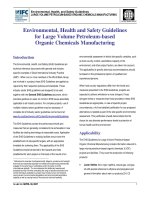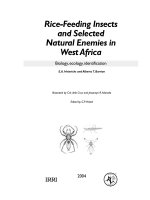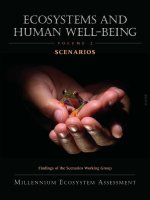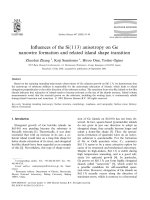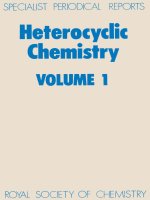Aliphatic and related natural product chemistry volume 2
Bạn đang xem bản rút gọn của tài liệu. Xem và tải ngay bản đầy đủ của tài liệu tại đây (21.31 MB, 284 trang )
www.pdfgrip.com
www.pdfgrip.com
Aliphatic and Related Natural
Product Chemistry
Volume 2
www.pdfgrip.com
www.pdfgrip.com
A Specialist Periodical Report
Aliphatic and Related Natural
Product Chemistry
Volume 2
A Review of the Literature published
during 1978 and 1979
Senior Reporter
F. D. Gunstone Department of Chemistry,
University of St Andrews
Reporters
R. A. Baker University of Southampton
J. W. S. Bradshaw University of Southampton
D. H. Grayson Trinity College, Dublin
R. C . F. Jones University of Nottingham
A. K. Lough Rowett Research Station, Bucksburn, Aberdeen
P. R. Marsham lCl Pharmaceuticals Division, Macclesfield, Cheshire
C . M. Scrimgeour University of St Andrews
The Royal Society of Chemistry
Burlington House, London WIV OBN
www.pdfgrip.com
British Library Cataloguing in Publication Data
Aliphatic and related natural product chemistry.Vol. 2. - (A Specialist periodical report)
1. Natural products
I. Gunstone, Frank Denby 11. Royal Society of Chemistry
547.705
QD415
ISBN 0-85 186-652-2
ISSN 0142-7318
Copyright 0 1981
The Royal Society of Chemistry
A l l Rights Reserved
No part o f this book may be reproduced or transmitted in any form
or by any means - graphic, electronic, including photocopying, recording,
taping, or information storage and retrieval systems - without
written permission from The Royal Society o f Chemistry
Set by Unicus Graphics Ltd, Horsham
and printed in Great Britain
by Whitstable Litho Ltd, Whitstable, Kent
www.pdfgrip.com
Foreword
Volume 1 of these Specialist Periodical Reports covered the two-year period
1976 and 1977, and this second volume covers the years 1978 and 1979. The
topics included are the same as in the earlier volume except that the chapter
on Marine Aliphatic Natural Products has been omitted because of unforeseen
difficulties which arose when it was too late t o make other arrangements.
I thank the Reporters for their contributions.
June 1980
F. D. GUNSTONE
www.pdfgrip.com
www.pdfgrip.com
Contents
Chapter 1
Natural Acetylenic and Olefinic Compounds,
excluding Marine Natural Products
1
By C. M. Scrimgeour
1 Introduction
1
2 Natural Acetylenic Compounds
Introduction
New Polyacetylenic Compounds
Other Acetylenic Compounds
Known Polyacetylenic Compounds
Structure Determination
Synthesis
Biosynthesis
Chemotaxonomy and Physiological Properties
1
1
1
11
12
14
14
15
17
3 Natural Olefinic Compounds
Introduction
Olefins Related to Acetylenes
Other Olefinic Compounds
17
17
18
18
Chapter 2 Acyclic Terpenoids
20
By D. H. Grayson
1 Introduction
20
2 Isoprene Chemistry
20
3 Artemisyl, Lavandulyl, and other Irregular Systems
22
4 2,6-DimethyloctaneGroup
Ocimenes
Myrcene Derivatives
Citronellyl Derivatives
Linalyl Derivatives
Citral and Derivatives
Geranyl and Neryl Compounds
24
24
25
28
29
30
32
5 Sesquiterpenes
39
6 Diterpenes and Sesterterpenes
43
www.pdfgrip.com
...
Aliphatic and Related Natural Product Chemistry
Vlll
7 Squalene Group
44
8 Polyterpenoids
44
Chapter 3 Insect Pheromones and Related Behaviour-
modify ing Chem icaIs
46
By R. Baker and J. W. S. Bradshaw
1 Introduction
46
2 Pheromones
46
46
51
52
53
54
56
Sex Pheromones of Lepidoptera
Other Compounds from Lepidoptera
Sex Pheromones of Coleoptera
Pheromones of Diptera
Other Responses to Pheromones
Hymenoptera - Social and Non-social
3 Defence Chemistry of Insects
59
4 Cuticular Hydrocarbons
59
5 Separation and Structure-elucidationTechniques
60
6 Synthetic Studies
Mono-unsaturated Derivatives
Di-unsaturated Derivatives
Tri-unsaturated Derivatives
Ketones and Acetate5
Enantiomer-specific Synthesis
60
61
66
69
71
72
Chapter 4 Olefinic Microbial Metabolites, including
Macrocyclic Compounds
By R.
76
C. F. Jones
1 Non-macrocyclicOlefinic Microbial Metabolites
Pyran-Pyranoid Compounds
Butenolide Metabolites
Tetronic Acids
Pulvinones
Miscellaneous
N-Heterocyclic Compounds
Pyrrolidines and Pyrroles
Piperidines and Pyridines
Pyrimidines
0ther Ni trogen-con taining Metabolites
76
76
81
81
84
84
85
85
88
90
90
www.pdfgrip.com
Conten ts
ix
Miscellaneous Olefinic Microbial Metabolites
Cyclopentene Metabolites
Cyclohexene Metabolites
2 Macrocyclic Olefimic Microbial Metabolites
Poly 0x0-Macrolides
Methymy cin
Maridomycins and Leucomycins
Deltamycins
Carbomycins
Staphococcomycin
Polyene Macrolides
Te traenes
Pentaenes
Heptaenes
Roridins and Verrucarins
Vermiculine and Pyrenophorin
Chlorothricolide
Brefeldins
Zearalenone
Recifeiolide
Diplodialides
Miscellaneous Macrocyclic Lactones
Cytochalasans and Aspochalasins
The Ansamycins
Rifamycins
Naphthomycins
Herbimy cin
Ansami tocins
Rubradirins
Other Macrocyclic Metabolites
Chapter 5 Prostaglandins
94
97
98
99
99
99
101
103
103
105
105
105
106
108
108
108
110
111
113
114
115
116
117
119
119
121
121
122
122
123
125
By P. R. Marsham
1 Introduction
125
2 Nomenclature
125
3 Synthesis of the Primary Prostagiandins
Corey’s Bicycle[ 2.2.llheptane Route
Modifications, and New Routes to Intermediates
Routes via Conjugate Addition to Cyclopentenones
New Syntheses of Intermediates
Modified Precursors of the Lower Side-chain
125
125
125
131
131
132
www.pdfgrip.com
Aliphatic and Related Natural Product Chemistry
X
Miscellaneous Syntheses
Prostaglandin D 1
133
133
4 Derivatives of Primary Prostaglandins
133
5 Synthesis of Prostaglandin A2
135
6 Synthesis of 19-Hydroxy-prostaglanddins
136
7 Synthesis of Prostaglandin C2
137
8 Synthesis of Prostaglandin H2
137
9 Prostaglandin 12
138
138
140
General Chemistry
Synthesis of Analogues
10 Synthesis of Modified Prostaglandins
Deoxy-prostaglandins
9-Deoxy-prostaglandins
11-Deoxy-prostaglandins
9,ll-Bisdeoxy-prostaglandins
15-Deoxy-prostaglandins
Cy clopentane-ring Variants
Aza-prostaglandins
Oxa-prostaglandins
Thia-prostaglandins
Cyclohexane-ring Analogues
H y dr oxy-prostaglandins
Mercapto-prostaglandins
Methyl-prostaglandins
Hydroxymeth yl-prostaglandins
Upper Side-chain Variants
Lower Side-chain Variants
A Bicyclic Prostaglandin
A 2,2-Substituted Cyclopentanone
epi-Prostaglandins
Chlorinated and Fluorinated Prostaglandins
Lactones from Prostaglandins
Endoperoxide Analogues
Analogues of Thromboxane A2
Seco-prostaglandins
Radiolabelled Prostaglandins
11 Metabolism
Natural Prostaglandins
Prostaglandin A1
Prostaglandin D2
150
150
150
151
154
155
156
156
163
164
164
166
166
167
167
168
173
176
177
177
179
181
181
185
186
187
188
188
188
188
www.pdfgrip.com
xi
Contents
Prostaglandins FZa! and F1,
Prostaglandin I2
Modified Prostaglandins
Thromboxane Bz
188
188
189
189
12 Biosynthesis and Biochemistry
191
13 Conformational Analysis
193
1 4 Determination
193
Chapter 6 Fatty
Acids and Glycerides
By F. 0.Gunstone
1 Books and Reviews
194
2 Natural Compounds: Occurrence and Identification
Unsaturated Acids
Oxygenated Acids
Cyclic and Branched-chain Acids
Other Long-chain Compounds
196
196
197
198
200
3 Synthetic Compounds
General Procedures
Synthetic Acids and Related Compounds
Lipid Synthesis
201
201
202
208
4 Physical Properties
Gas-Liquid Chromatography
High-performance Liquid Chromatography
N.M.R. Spectroscopy
Mass Spectrometry
Crystal Structure and Polymorphism
Other Physical Properties
209
209
209
210
210
211
211
5 Chemical Reactions
Hydroperoxides: Formation and Reactions
Hydrogenation
Other Reactions of the Double Bond
Reactions of the Carboxyl Group
212
212
217
218
219
6 Biological Reactions
Fatty Acid Synthetase
Chain-elongation and DesaturaTion
Essential Fatty Acids
Biosynthesis and Metabolism
Waxes
219
219
220
221
222
22 3
www.pdfgrip.com
Aliphatic and Related Natural Product Chemistry
xii
Chapter 7 Polar
Lipids
224
B y A . K. Lough
1 Introduction
224
2 Natural Lipids
Glycerophospholipids
Phosphatidylthreonine
Phosp hogly colipids
Glycosphingolipids
Sphingophosphonolipids
Gly colipids
Sulpholipids
Lipo-amino-acids and Lipopeptides
Lignan Diester
224
224
225
225
226
226
227
228
228
228
3 Chemical Synthesis
Glycerophospholipids
Sulpholipids
Deuteriated Polar Lipids
Tritiated Lipids
Glycolipids
Ph osphoglycolipids
Sphingolipids
Glucosylceramide
N-Acy 1-amino-acids
Spin- and Fluorescence-labelled Lipids
229
229
235
235
235
235
236
236
237
237
238
4 Biochemical Transformations
Biosynthesis of Polar Lipids
Chemical/Biochemical Synthesis
238
238
239
5 Stereochemistry
Glycerophosphates
Sphingolipids
240
240
240
6 Physical Chemistry
Conformational Studies
Studies of Phase Transitions
Hydration of Phospholipids
Phospholipid-Cation Interactions
Micellar Studies
241
241
242
243
243
243
7 Preparation and Determination
244
244
245
245
Extraction and Isolation
Preparation of Glycerophospholipids
High-performance Liquid Chromatography
www.pdfgrip.com
...
Contents
Xlll
Modified Silicates and Resin Column-support Materials
Thin-layer Chroma tograp h y
Spray Reagents
Determination of Phospholipids
Determination of Glycolipids
245
245
246
246
247
8 Biological Aspects
Lipid-Protein Studies
Enzymic Aspects
Physiological Aspects
Miscellaneous
247
247
248
248
248
9 Reviews
249
Author Index
251
www.pdfgrip.com
www.pdfgrip.com
I
Natural Acetylenic and Olefinic Compounds,
excluding Marine Natural Products
C.M.SCRIMGEOUR
1 Introduction
This report covers the same topics as does the corresponding chapter in the
first volume of this series. The bulk of it is concerned with polyacetylenic and
other acetylenic aliphatic natural products while the remainder deals with
olefinic compounds not obviously included in the other chapters. The literature coverage is for 1978-9 plus a few earlier reports not previously included.
2 Natural Acetylenic Compounds
Introduction. - This two-year spell has again been one of consolidation rather
than dramatic progress. A number of new compounds, mainly related t o
previously known structures, have been reported. A number of new sources
of known compounds have also been reported. Many of these reports concern
the physiological role or chemotaxonomic application of acetylenic compounds. Four general reviews about polyacetylenes have appeared,’+ covering
the work of the past decade or more. While Bohlmann’s output has continued
to focus on terpenoid compounds, he still remains the most prolific contributor t o this field.
New Polyacetylenic Compounds. - The majority of new compounds are found
in species within the family Compositae. A CISenediynene (1) and the related
dihydro-compound (2) were isolated from the roots of various South African
species of the genera Athanasia and Pentzia.’ These acids are of interest as
possible intermediates in the biosynthesis of polyacetylenes from crepenynic
acid. The linoleyl ester of (1) was also identified! In his continuing study of
South African members of the Compositae, Bohlmann identified a related
pair of C18 compounds ( 3 ) and (4) from a number of species of Seneciu.’ The
E. R. H. Jones and V. Thaller,Methodicum Chimicum, 1978,11, 175.
‘The Chemistry of the Carbon-CarbonTriple Bond’,
ed. S. Patai, John Wiley, London, 1978, Ch. 14.
K. E. Schulte, East. Pham., 1979,22, 85.
K. E. Schulte, Korean J. Pharmacogn. (Saeng’yakhakJoeji), 1978,9, 11.
F. Bohlmann and C. Zdero, Phytochemistry, 1978,17, 1595.
F. Bohlmann and K.-H. Knoll, Phytochemistry, 1979, 18,995.
F. Bohlmann, C. Zdero, and A. A. Natu, Phytochernistry, 1978, 17, 1757.
’ E. R. H. Jones and V. Thaller, in
’
’
www.pdfgrip.com
2
Aliphatic and Related Natural Product Chemistry
two c18 compounds (1) and (2) have also been reported, occurring a s their
methyl esters in Athanasia tridens,' along with the new C17 olefin derivative
(5). Bohlman has suggested that (5) is biosynthesized by loss of carbon
dioxide and water from the P-hydroxy c18 compound ( 6 ) . Clibadium cf.
glomeratum has also yielded a new C17 compound (7).' Further C1, compounds are related to dehydrofalcarinone; (8) and ( 9 ) were identified in
various South African species of Nidorella,lowhile the South American Diotis
maritima yielded the dihydroderivative ( l o ) , related to (8)." One new C16
compound has been identified. The aldehyde (11) was found in Siegesbekia
jorullensis. l 2
A number of C13 and C14 compounds have also been reported from various
members of the Compositae. Bohlmann identified four new thiophen derivatives (12)-(15) from Cullumia setosa,13 along with other known thiophens.
A polyacetylene has been isolated for the first time from Brickellia Ea~iniata.'~
This is a new C14compound, with a novel pattern of unsaturation (16), and it
occurs as a mixture of stereoisomers. The stereochemistry has not yet been
determined. A study of compounds that are capable of stimulating the
germination of safflower rust (Puccinia carthami) and which are produced by
germinating safflower (Carthamus tinctorius) revealed a number of poly-
lo
l3
l4
F. Bohlmann and C. Zdero, Phytochemistry, 1979,18, 1736.
H. Czerson, F. Bohlrnann, T. F. Stuessy, and N. H. Fischer, Phytochemistry, 1979,18,
257.
F. Bohlmann and U. Fritz, Phytochemistry, 1978,17,1769.
J. de Pascual Teresa, A. F. Barrero, and A. San Feliciano, An. Fig Quim., Ser. B,
Quim., 1977,73, 1525.
F. Bohlmann, J . Jakupovic, C. Zdero, R. M. King, and H. Robinson, Phytochemistry,
1979,18,625.
F. Bohlmann and K.-H. Knoll, Phyfochemistry, 1979,18,1060.
F. Bohlinann, A. Suwita, and T. J . Mabry, Phytochemistry, 1978,17, 763.
www.pdfgrip.com
3
Natural Acetylenic and Olefinic Compounds
OAc
-
-
OH
(8)
I
OH
(12) R = H
(13) R = Me
(14) R = H
(15) R = Me
-----www.pdfgrip.com
4
Aliphatic and Related Natural Product Chemistry
-
-
-
-
/
(19)
acetylenic hydrocarbon^.'^ A number of these are C13 compounds that are
new to this well-studied species, and (17)-( 19) are new compounds. A careful
re-examination of t h e polar fraction of the aerial parts of Centaurea ruthenica
revealed over twenty new compound^.^^ Most of these are C13 compounds,
along with some Czo and C14 compounds, all of them present in trace
amounts. Complete separation of the components was not always possible,
but the structures (20)-(48) were unravelled from spectroscopic evidence.
'The new compounds help t o extend the biosynthetic schemes for these
compounds.
OH
= -
(21) R = H
(22) R = OH
OH
15
l6
R. G. Binder, R . E. Lundin, S. Kint, J . M. Klisiewicz, and A. C. Waiss, Jr., Phytochemistry, 1978,17, 315.
R. Jente, F. Bohlmann, and S. Schoneweiss, Phytochemistry, 1979, 18, 829.
www.pdfgrip.com
Natural Acetylenic and Olefinic Compounds
\
5
www.pdfgrip.com
6
Aliphatic and Related Natural Product Chemistry
R2
(35) R' = Ac, Rz= OH
(36) R' = H, R2= OMe
(37) R' = Ac, R2= OH
(38) R' = H, Rz= OMe
R2
I
_
-
-
0R'
-
(39) R' = Ac, R2= OH
(40) R' = H, R2 = OAc
(42) R ' = H , R2= OAc
-
-
Ri
OH
-
OH
(45)
%
HO
www.pdfgrip.com
7
Natural Acetylenic and Olefinic Compounds
-
-
-
-
OAc
(47)
Bohlmann has also discovered a number of C I 2 compounds among
members of the family Compositae. The sulphur-containing compound (49)
occurs in Chrysanthemum coronarium, along with a number of known,
related cornpound~.'~ErniZiacoccinea and E. sagittata afforded a number of
C12 compounds (50)-( 54),which are suggested as the biosynthetic precursors
of the better known CI1 compounds.'* Two representatives (55) and ( 5 6 ) of
a new type of chloro-aromatic thiophen compound occur in Helichrysum
tenuifolium and H, pandumturn, along with the related, non-aromatized
compound (57).19 A chloro-enol ether (58) has been proposed as the biosynthetic precursor of these compounds, as shown in Scheme 1.
R = Me
(51) R = H
(50)
(52) R = Me
(53) R = H
l8
l9
OH
OH
OH
(54)
F. Bohlmann and U. Fritz,PhytochePnistry, 1979,18, 1888.
F. Bohlmann and K.-H. Knoll,Phytochemistry, 1978, 17,557.
F. Bohlmann and W.-R.Abraham, Phytuchemistry, 1 9 7 9 , 1 8 , 839.
www.pdfgrip.com
8
Aliphatic and Related Natural Product Chemistry
= J Q
-
0
a
c1
(56)
(55)
OH
Q
-
G
C
OMe
l
(57)
hr
rv
rv
hr
Scheme 1
hr
hr
hr
N
www.pdfgrip.com
Natural Acetylenic and Olefinic Compounds
9
A number of Cll acetylenes (59)-(67) occur in Cineraria species,20and the
chemotaxonomy of the genus Cineraria is discussed by Bohlmann with reference to these and related compounds. Several sources of new Clo compounds
have been found. These compounds are derivatives of matricaria ester, with
which they often co-occur. The lactme ( 6 8 ) was isolated from Solidago
altissima,21 and the seasonal variation of its concentration and those of
matricaria ester and dehydromatricaria ester was observed. Chrysotharnnus
parryi gave four new derivatives of matricaria ester, i.e. (69)-(75).22A number
o f known compounds were isolated from Artemisia absinthium, along with a
new thiophen derivative of dehydromatricaria ester ( 76).23Two C l o furanoacetylenes ( 7 7 ) and ( 7 8 ) were identified in Felicia f i l i f ~ l i a . ~ ~
(72) R = OAc
(73)R=OH
(70) R = 0
2o
21
22
23
24
F. Bohlmann and W.-R. Abraham, Phytochemistvy, 1978, 17, 1629.
K.-I. Ichihara, T. Kawai, and M. Noda, Agric. Biol. Chem., 1978, 42, 427.
F. Bohlmann, C . Zdero, H . Robinson, and R . M. King, Phytochemistry, 1979, 18,
1519.
H. Greger, Phytochemistry, 1978, 17,806.
F. Bohlmann and U. Fritz, Phytochemistvy, 1979, 18, 1221.


